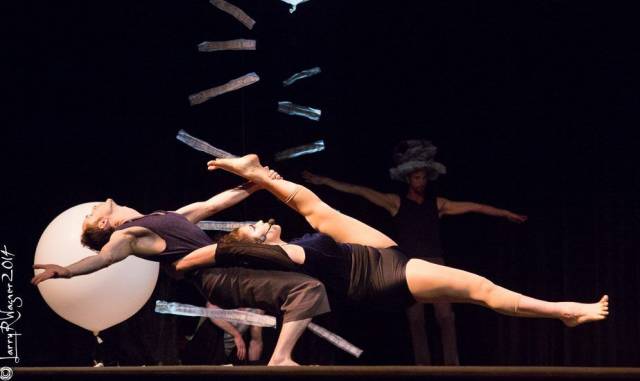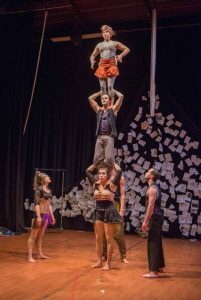

Acrobatic Conundrum, Seattle's premier contemporary circus arts company, will be performing The Language of Chance at the NYU Skirball Center on January 14th as part of Circus Now 2016. Acrobatic Conundrum is led by Artistic Director and Co-founder, Terry Crane, an expert at vertical rope and practitioner of capoeira, contact improvisation, hip-hop dance, physical theater, and tree climbing. The ensemble-based company, which he founded in 2012, blends circus, dance, and physical theater to create poetic work that is beautiful, deep, relatable and even a bit absurd. The company has performed internationally and in 2015 received the City of Seattle’s CityArtist Projects Award.
The Language of Chance is a two-part production comprised of “A Book is Not a Ladder,” directed and choreographed by KT Niehoff, and “Secret Passages,” directed by Elizabeth Klob and choreographed by Katheryn Reed. The work is performed by Terry Crane, Carey Cramer Nicolo Kehrwald, Jacki Ward Kehrwald, Erica Rubinstein, and Ty Vennewitz. I was able to steal a bit of Terry’s time to find out a little bit more about his work, the upcoming performance, and what it’s like to be a circus performer.
Can you tell us a bit about the evolution of Acrobatic Conundrum since you started the company in 2012?
What originally started out as a local effort to showcase circus artists doing edgier, expressive work has blossomed into a nationally reputed touring company. It’s been a busy three years. For our first show we wanted to present acts that all had some new risk in them for the performers, something that would genuinely take them out of their comfort zone, so that we could share a new level of vulnerability with our audiences, i.e. risks like performing blind-folded, or performing a single act in three distinct vignettes, or mixing disciplines in ways that were new for us. The goal was experiment with the medium and make some discoveries, even if there were some moments that fell flat. It resulted in a palpably electric ambiance in the room, between the crowd and performers, and that’s carried through to our current shows. Since the first show in Seattle, we’ve performed across the country and in Canada, and now Egypt, but the principles of challenging ourselves, being vulnerable, and striving to connect with the audience are intact.
The Circus Now! series includes many other circus artists and companies. What do you feel ultimately connects you with others and what sets Acrobatic Conundrum apart?
I think we’re connected in our aspirations to create vibrant live, athletic theater and perform it. I always find this kind of confluence of circus companies of different nationalities and styles really inspiring and motivating. What connects us is circus.
Acrobatic Conundrum is different because of our passports. We are a U.S. contemporary circus company, which is a rarity. Also, our work is very ensemble based, and I think the work reflects our process of collaboration, our dedication to making it work together. The show we’ll be presenting on January 14th is comprised of two unique collaborations with artistic directors, one from the dance world and one from physical theater. Onstage you’ll see some of our signature vertical rope work, and Erica Rubinstein, a female partner acrobatics base who lifts her partner above her head with grace and power.

You are trained in many disciplines and particularly practice vertical rope. What is a typical day in the life of a circus artist? How do you prepare your body for such challenging physicality?
Typically, I spend 2-3 hours a day, 5 days a week training. Less, if I’m currently in a show. Time off from shows gives me a chance to research and work on new material. I can’t help wanting to learn new things in circus; I have too many loves—rope, hand to hand acrobatics, Cyr wheel, duo trapeze. Circus gives you the opportunity to learn life-long, and play this infinite game of forever pushing the technical envelope further and further. Not sure I’m answering the question here…. So, in a typical day, I eat a lot more than the USRDA of calories (even though I’m light at 130 lbs.), lots of veggies and protein. During a show period like at present, I tend to go to bed late and wake up late because it takes awhile to come down from the high of performing. Health-wise, I am a devotee of physical therapy, yoga and having a pro-active diet.
Rope Battle Royale is a piece you choreographed where, while performing it, you shout out the names of those whose moves you’ve “stolen” (and made your own). How common is it that rope artists, or perhaps circus artists in general, build upon and share each others’ movements?
It’s a language we all speak and the words are being invented all the time, shared in performances or over the internet in videos. Circus has a long history, with proud and ignominious episodes, and even the most contemporary circus is connected to that past. Its fun to do a piece that overtly celebrates those connections. Just as the good jokes in comedy and vaudeville get retold and recontextualized, aerialists and circus artists are influenced by the body of tricks that has already been created. I’m biased, but I think rope artists are particularly community oriented, and the dialogue we have with each other has made the form developed even faster.
Who or what has been an inspiration for or influence on The Language of Chance, and what will the audience be able to take away from it on January 14th?
The original inspiration for the show began with a story by Jorge Luis Borges, "The Library of Babel." I have always found the imaginary world of the story evocative. The world is a bit dark, but always teasing you with another piece of the puzzle. It’s a piece about hope and despair, and ultimately about how a group works and find meaning together. The audience will see Jacki Ward Kehrwald’s unparalleled contortion handbalancing piece, Ty Vennewitz’s uniquely charming clowning and hula hoops. They’ll see variations on old themes of circus in a new context. Hopefully everyone will take away something different.
From what I understand, you began your training at age 20. What advice would you give to a 20-year-old who wants to become a circus artist.
Ha. Good question. I’d say go for it. I think it’s easy to spin your wheels and get nowhere if you go just partway in. If you’ve taken some classes or trained for a while recreationally, so you know you’re really in love with the form, I would say save up some cash and then go in whole-hog. Ideally leave home and go somewhere you can really focus on your training. The ideal situation for me at age 21 at Circus Center in San Francisco was having good teachers, peers who had similar goals, and enough structure that I could be very consistent about my training. Making a living as a performer takes a lot of persistence and even so the dream of complete independence from a job that’s not your passion may never get realized. But circus is something special that you can channel your whole expression into; for me the things I put on stage are an extension of myself. Being able to have that seen and appreciated is worth it.
Acrobatic Conundrum perform The Language of Chance at the NYU Skirball Center on January 14th as part of Circus Now 2016 (January 14-16).